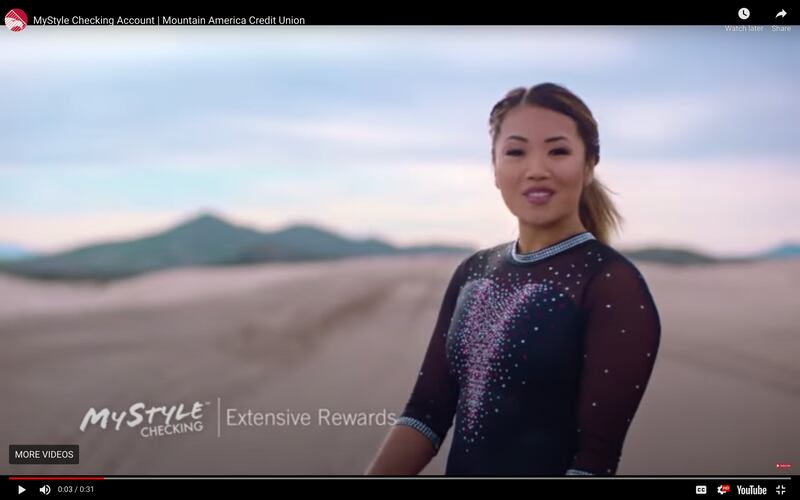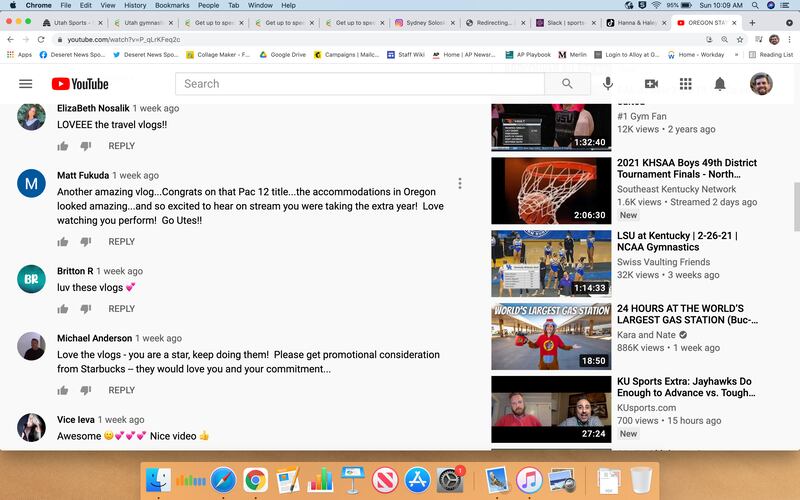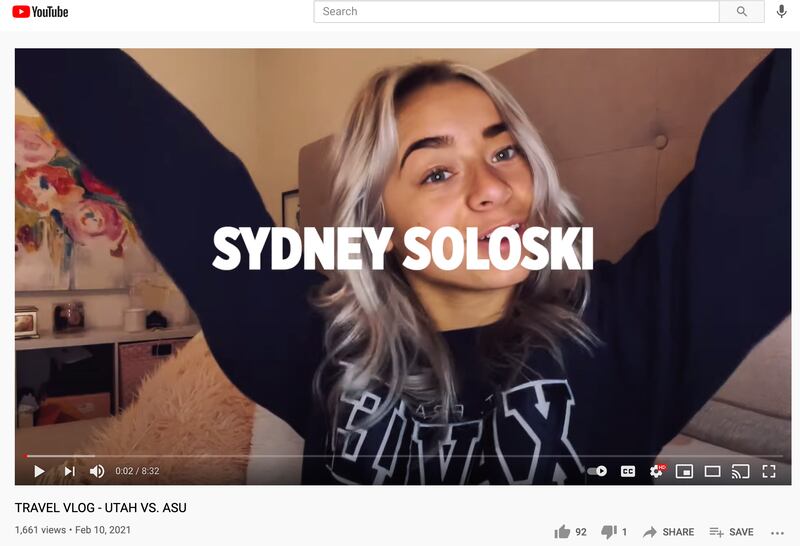It starts with Sydney Soloski sitting in her room. She smiles as her name flashes across the screen and welcomes viewers to her YouTube channel.
Week after week this gymnastics season, Soloski — a gymnast at the University of Utah in Salt Lake City — has posted vlogs on YouTube, giving fans a sneak peek into the goings on before and after meets.
Each video is unique, centered on that week’s meet, but large cups of coffee usually make an appearance. Fellow Utah gymnasts are usually shown laughing, joking or otherwise meandering about and video of Soloski competing is always a highlight.
At first glance, the vlogs appear to be all in harmless fun. Soloski is a senior and while she recently announced that she will be returning to the U. for an additional season, it made sense that she would do something unique and fun for what was going to be her final year.
There is an underlying motivation behind her vlogs, though. Something that she describes as being in the back of her head, even as she says in the same breath, “I don’t really have a definitive goal — I just want to see where things go.”
“Yeah, I’ll definitely own up to that. As I was gearing up for my senior year, I thought about that, being able to make money. And I looked at it as I’ve dedicated so much of my life to this (sport). It is a lot of my identity. So why not try? If it makes me money, great. If not, I still enjoy doing it.” — Sydney Soloski, on starting a vlog
Soloski wants to make money.
“Yeah, I’ll definitely own up to that,” she said. “As I was gearing up for my senior year, I thought about that, being able to make money. And I looked at it as I’ve dedicated so much of my life to this (sport). It is a lot of my identity. So why not try? If it makes me money, great. If not, I still enjoy doing it.”
The thing is, right now Soloski, like all NCAA athletes, cannot make money. She can’t hold a job, nor can she profit off her name, image or likeness. She can’t be sponsored nor can she be paid by YouTube, even if her vlogs were to take off.
All of it is prohibited by the NCAA.
Soloski knew that when she created her vlog, so right now she is simply trying to build her following and gain enough prominence so that when she is allowed to, she will be able to profit.
In a recent ESPN article about how changes to name, image or likeness rules — commonly referred to as NIL — will benefit athlete-influencers in the NCAA, David M. Hale details more than a few NCAA athletes who, due to their social media followings, will be capable of making not-so-insignificant amounts of money when NIL reform comes (that reform may be here as soon as this summer).
There are Fresno State basketball players and sisters Hanna and Haley Cavinder, whose TikTok videos have earned them 2.7 million followers. Additionally, Nebraska volleyball player Lexi Sun has more social media followers than any athlete at the school, which is one of the most football-centric universities in the country. Then there is LSU freshman gymnast Olivia Dunne, whose social media following on Instagram, TikTok and Twitter adds up to nearly 5 million.
All will be capable of making money when NIL reform comes, on par with college football and men’s college basketball stars.
Chloe V. Mitchell, a freshman volleyball player at Aquinas College in Grand Rapids, Michigan, has already proven that. As detailed in a recent profile by CNBC’s Abigail Johnson Hess, Mitchell competes at the NAIA (National Association of Intercollegiate Athletics) level and that organization has already passed legislation that allows its student-athletes to be compensated for use of their name, image and likeness.
Like the Cavinder sisters, Mitchell is a TikTok sensation, and sponsorships have followed, sponsorships that she has been able to maintain while competing.
A recent joint study done by AthleticDirectorU and Navigate found that the most popular (on social media) female gymnasts in the country in 2019 — UCLA’s Madison Kocian, Kyla Ross and Nia Dennis, as well as West Virginia’s Erica Fontaine and Chloe Cluchey — could have earned endorsements ranging between $150,000 and nearly $500,000 based off their social media followings.
On YouTube itself, Soloski’s chosen platform, stars usually make a couple thousands dollars for every million views or so, according to Business Insider, and the more subscribers the more money made. One YouTube star reported that he made $6,000 this past November, with 165,000 subscribers, while another pocketed $40,000 in August of last year thanks to his 844,000 subscribers.
While not every collegiate athlete will be able to bring in that kind of money, Mitchell told CNBC her endorsements were enough to pay for a new computer for her first semester of school.
That, ultimately, is the aim of most athletes when it comes to NIL.
“It is a huge thing for NCAA athletes,” Soloski said. “I think (allowing us to profit off our NIL) is a step in the right direction, even as much as I think it might be a crap shoot, too.”
Opportunities abound
While Soloski has nowhere near the social media presence of those influencers or athletes just yet, thanks to more traditional avenues like television commercials or other advertisements (billboards, online ads, etc.), money-making opportunities would be available if they were within NCAA rules.
That shouldn’t be a surprise either, given the volume of fans Utah’s gymnastics program has accumulated over the years.
“Utah obviously has a unique situation with a large fan following here in the (Salt Lake) valley and at our meets,” head coach Tom Farden said. “It would be hard to imagine that there wouldn’t be opportunities for our athletes.”
Some Red Rocks have already taken advantage of that — after graduation — and gone ahead and profited off their NIL.
Take former Utah gymnast Kari Lee.
Now Kari Nguyen (she married in July 2019), Lee starred in a commercial for Mountain America Credit Union, a spot that still airs today.
How Lee was tabbed to be in it is most instructive.
At the close of the 2018-19 season, Lee’s last at Utah, she was approached by Anne Marie Jensen, channel manager for sponsorships and events at Mountain America Credit Union. Jensen is Utah’s meet director — she oversees all volunteers — and has been since 1984.
The credit union wanted to film a commercial and include a Utah gymnast, so Jensen was asked “if there was anyone (at Utah) who was possibly interested.”
“But with how the NCAA works, you can’t get paid for doing that,” Lee said, “so they needed an athlete that was going to graduate. I was graduating in 2019 so Anne Marie thought of me.”
That was all it took for Lee to be put in a situation to profit off her NLI.
The process of filming the commercial was much more laborious and illustrative as to why NIL issues have yet to be resolved.
“I understand why the NCAA put rules on doing something like this because it can get very complicated,” Lee said.
She spent about day and a half on the commercial, including travel, an overnight stay in a hotel, actual filming and other promotions. But before filming anything, she had to secure a leotard, which proved a complicated process. Lee was wanted for the commercial because she had been a Red Rock, but she could not officially represent the University of Utah in any way in the ad, so she couldn’t use a Utah leotard.
She got around it almost by luck. Her sister had designed leotards for their gym in Arizona — Flames Gymnastics Academy in Peoria — and while at Utah, Lee had pitched one of her sister’s designs to former Utah co-head coach Megan Marsden.
The Red Rocks ultimately used a version of that design for one of their leotards, so Lee borrowed one of the original leotards from her home gym for the commercial. It wasn’t a Utah leotard, but it was close enough.

When it came to actually filming the spot, Lee had to travel multiple hours to a location in the sand dunes and wake up at 4 a.m. to get on set before sunrise. Filming did not take place at the hoped-for time, as the production had to borrow a balance beam from Olympus Gymnastics in South Jordan and the beam was delayed.
Once filming began, Lee had to complete an aerial on the beam. It was really the only skill she felt comfortable doing months after her retirement from the sport. Over and over and over again, however, she fell.
“I was getting so frustrated,” Lee said laughing, now nearly two years later. “The beam was kind of crooked, because sand dunes aren’t level, so I kept falling on an aerial and was like, ‘Why am I falling?’”
Eventually she asked the production team to shove some sand under one end of the beam and it paid off.
“I stuck every single aerial after that,” Lee said, defiantly.
The commercial itself took close to eight hours to complete, from 5 a.m. to 1 p.m., and then Lee had to do some Instagram promotions and a voice-over for radio.
“It was a whole process,” she said.
One which she believes will be available to Utah gymnasts in due time, though she wonders whether those opportunities should be available or not, based off her own experience.
“Since Utah gymnastics is such a huge thing in Salt Lake City, I feel like in the future that will be a possibility,” Lee said. “But I also feel there will be boundaries. There is such a fine line for being paid for something and also searching to get paid. If the opportunity comes to you, I feel like there shouldn’t be a problem doing it, but if you are searching for it, that is when the line can be crossed.
“At Utah, you are being recruited there for gymnastics. Being paid isn’t something you should search for, because that isn’t your No. 1 priority,” she said. “I feel like if people were to come and it was something you’d like to do, then it’d be a possibility, but then you might have to get agents and stuff gets really complicated. I understand why the NCAA put rules on doing something like that because it can get very complicated, especially if you are more ‘famous.’”
Beyond the money
Soloski’s motivations for her vlog do go beyond any future earning potential. The project was conceived early in the pandemic because she was, as she puts it, “so bored.”
“I had so much time on my hands, so I thought, ‘What can I do that feels authentic to me that I want to share with people?’” she said.
Conversations with friends soon convinced her that YouTube was the route she should take, in part because her personality would shine through on that platform the most.
“They told me that they thought I’d be great at YouTube,” Soloski said. “They also thought that people would be super interested to see behind the scenes of what it is like to be not only a gymnast, but an NCAA athlete.”
Given the unique experience of being a student-athlete during the pandemic, Soloski agreed.
“What a time to show people what it is really like, ’cause there has never been a time like this before,” she said.
All that engenders the question, though, of why share anything at all? Soloski could have continued on as she had done the previous three seasons of her Utah career, interacting with fans on Instagram and Twitter and left it at that. She has an answer to that. In a word: fame. Ever since she was a little girl, Soloski has had what she describes as an “obsession” with being famous.
“I was always obsessed with being famous and those kinds of things,” she said. “As I’ve gotten older I’ve realized I don’t want to be front cover of a magazine type of famous, but I am someone who loves social media.”
That love derives in part simply from growing up in the era she did. (When asked about it, she was a bit incredulous. How could someone not love social media?)
That said, social media gave her the ability to connect with teammates when she was a member of the Canadian National team, teammates who were spread thin across the massive country. There is also the “boost of serotonin you get when people like your posts,” she added, and Soloski likes that she has a platform on which she can share her opinions.
But with a tinge of disappointment in her voice, she added, “there is always an extent to it.”
As Soloski sees it, she was limited in scope by Instagram and Twitter — she has 9,191 followers on the former, 1,631 on the latter — and YouTube provided the opportunity for her to get her name out there even more.
She also never would have taken on the project of a vlog had it not been something she enjoys in and of itself, from creating it to producing it and reveling in the responses.
Reception and creation
As of March 25, Soloski has 889 subscribers, and the videos have all received over 1,000 views, some well over 2,000. Moreover, her vlog has been discussed on almost every television broadcast or livestream of a Utah meet this season.
Soloski hasn’t had much in the way of negative reviews, either. It has been mostly positive praise.
“So far I have only gotten positive ones. I’m sure there are people who think negatively about it, but they haven’t told me,” she said with a laugh. “I get lots of comments and have had great responses to it, with people saying they can’t wait to see the next one or asking me to vlog about this, or to add that.”
A significant portion of her audience is European gymnastics fans who routinely comment on how they do not have collegiate sports in their countries and appreciate her videos giving them a glimpse into the sport in America. Soloski, for her part, listens to the suggestions of her fans. Or tries to at least, while trying to be as authentic and genuine in her videos as possible.
“I do kind of listen to the stuff that people want to hear and then I run all my stuff by my family and see what they think of it,” she said.

She doesn’t follow a script or really plan out her videos. As she puts it, she “pretty much just spontaneously records.”
It is all part of her commitment to “keep it authentic.”
“It is definitely authentic, and everything I show on there is pretty much who I am,” she said. “I take into consideration what people want to see, but I want to keep it how I wanted it to.”
And thus far, she has been nothing if not successful at it.
“I think it is a reflection of her personality,” Farden said.
And who knows, by the beginning of next season Soloski might be able to profit off her personality, while simultaneously providing a blueprint for future Red Rocks to follow.


 alt=Trent Wood
alt=Trent Wood